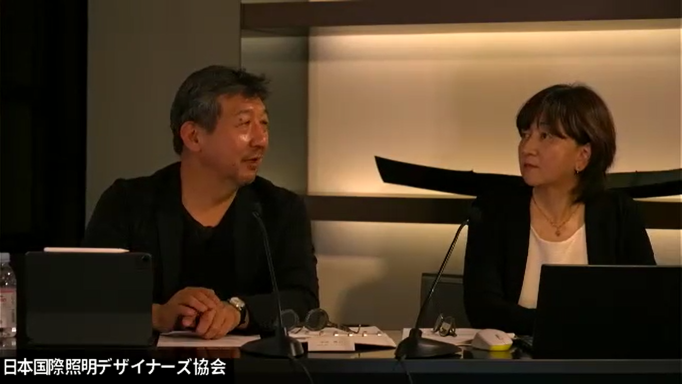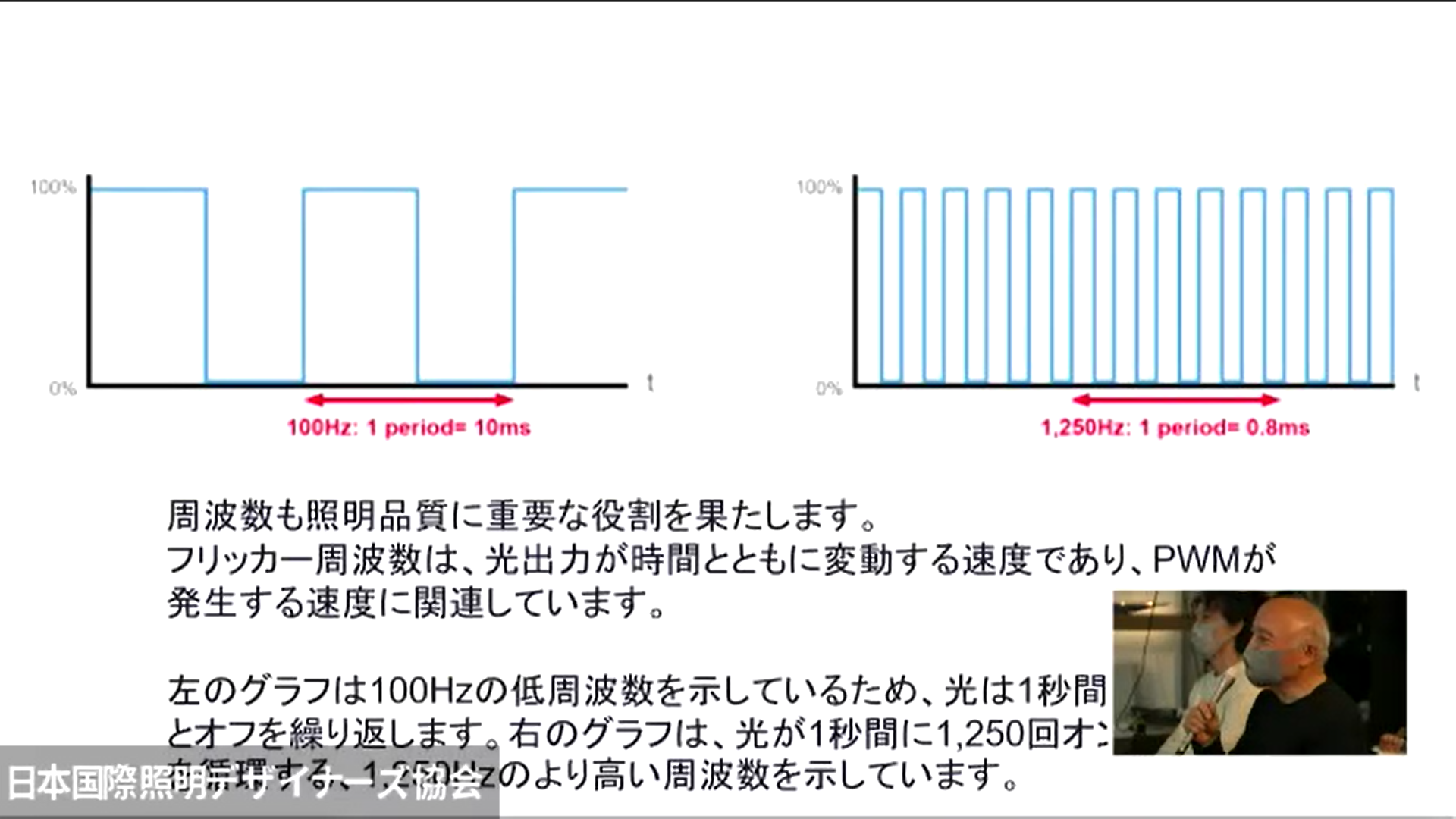Activity
Event/Workshop Report
2022.12.23
The 10th IALD Japan Webinar “What is WBS?”
WELL Building Standard (WELL) was developed in 2014 as a system to evaluate built environments. Characterized by its emphasis on people’s health and well-being at the center of environmental design, it has attracted attention from offices, hotels, and commercial facilities around the world. What exactly is WELL, and how can we as lighting designers contribute to WELL certification? In order to unravel these questions, the webinar “What is WELL?” was held on December 9th. This was the first IALD Japan webinar held as a hybrid event, with an audience gathering at the Tokyo Design Center crafTec Gallery as well as online. The moderators were Atsushi Kaneda (WORKTECHT&Co.) and Tomomi Meguro (tomoru design, meguro inc.).

The webinar opened with an introduction of the 10 concepts in WELL (air, water, nourishment, light, movement, thermal comfort, sound, materials, mind, and community), followed by introductions of other building rating systems used worldwide, such as LEED and CASBEE. After that, a promotional video was shown, showcasing WELL certified offices around the world along with comments from the business owner. Kaneda and Meguro commented, “Whilst there are currently few offices in Japan with such high environmental quality, this is expected to be the future direction that we will move towards.”
Next, participants were asked if they create offices with WELL certification in mind. A lighting designer in the audience answered that although he is not particularly conscious of WELL certification, his viewpoint of offices as more of a playground than a workspace inevitably leads to creating a comfortable space. A lighting manufacturer, who was also in the audience, shared that his company has not received WELL certification for its office, but was involved in the lighting control of a hotel project that achieved WELL certification.
An online survey showed that 5 respondents had been involved in WELL certification, and 22 respondents had not.
In the world ranking of the number of WELL certified buildings, Japan ranked 12th. The U.S. topped the list by a landslide, and China came third with a surprising large number. As seen from the responses from the audience and online survey, WELL is not widely known in Japan, and projects that achieve WELL certification tend to be buildings belonging to general contractors and organizational design firms.
Of the 10 concepts in WELL, “light” was allocated 18 points out of 110 and Kaneda commented that “lighting accounts for a large proportion of WELL”. The 18 points are divided into Preconditions and Optimizations, with the preconditions being light exposure and visual lighting design, and the optimizations being circadian lighting design, electric light glare control, and daylight simulation, among many others.
Meguro also presented the IWBI list used by LEED and WELL consultants, saying, “I was surprised at how detailed the list is. We lighting designers need to contribute to WELL certification by taking into account not only the mandatory items but also the optimization items when working on designs.”
Kaneda stated that “WELL certification is granted to spaces and buildings, not to individual products, and we are being tested on whether we can select products that are suitable in achieving WELL certification”, indicating the role that will be required of lighting designers in the future.

There was a comment from a lighting designer in the audience, saying “Most of the items listed as requirements for WELL certification are things that lighting designers in Japan consider as a matter of course. WELL certification may serve to raise the general standard, but otherwise I feel it will be difficult for WELL certification to be widely accepted in Japan.” In response, Kaneda explained that “WELL certification serves a purpose similar to the Michelin star system, as clear-cut indicators of quality. It’s important to recognize the increasing need for such systems.” Another lighting designer in the audience commented, “Similar to Olympic medals, comprehensible measurements help clarify the goals of each project. WELL certification should also be widely promoted to help drive out the use of JIS recommended values”, touching on the importance of WELL certification being widely accepted in Japan.

Next, Meguro highlighted key points in the Optimizations.
First, circadian lighting design. The intent of circadian lighting is to reinforce the circadian rhythm and facilitate better sleep through effective use of light – activating the body through 4 hours of daytime light during the day and lowering the color temperature in the evening to stimulate melatonin production. Meguro introduced Equivalent Melanopic Lux (EML), a metric that measures the effect of circadian lighting. Kaneda shared that there are EML research facilities in Canada and Taiwan, where experimental studies are being conducted.
On the topic of daylight simulation, the moderators shared examples of verification by computer simulation. However, in reality daylight changes depending on direction (north, south, east, west) and the time of day; therefore daytime simulation may be a more complex issue in practice.
The next topic was “How to prevent flicker”, a subject on which Meguro was personally interested in hearing from an expert.
Flicker is a flickering phenomenon, also called the moiré phenomenon, seen in LEDs, which can cause physical discomfort due to the rapid changes in brightness of light. The international standard for evaluating flicker is 3kHz, but Japan uses the PWM system and has a looser standard of 100V 50Hz to 60Hz.

Kaneda asked the guest of the event, Kunio Tamada (TamaTechLab.) to share his view. Tamada is a specialist in this field, with many years of experience in stage and television lighting. He said, “The equipment used at television stations have a frequency of 5kHz or more – it can be higher than 20kHz in the latest equipment. PWM is relatively easy to control but can cause flicker, so I use a dedicated flicker-free power supply that allows for variable current and consistent voltage. Television stations are particularly nervous about flicker, so flicker-free current control in general is becoming more common.”
Finally, a video of Google’s office in California which was certified LEED platinum was shared to the audience, and they were invited to share their thoughts. Meguro commented, “WELL certification is achieved not only by lighting designers, but through collaboration of all parties from various industries involved in the project. In the field of lighting, we would like to move towards the theme of health and welfare with the support and understanding of lighting manufacturers.”
Kaneda said, “Standards such as WELL and LEED are a global trend, and we need to recognize, study, and reflect this in our work. I will keep the vision, the future of lighting in my mind when creating designs,” bringing the webinar to a close.
【Date】 December 9, 2022
【Venue】Tokyo Design Center crafTec Gallery + IALD Japan WEBINAR
【Moderator】Atsushi Kaneda, Tomomi Meguro
【Organizer】IALD Japan
